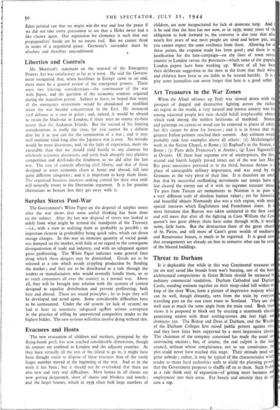Art Treasures in the War Zones When the Allied advance
up Italy was slowed down with th prospect of dogged and destructive fighting across the rich art region in the world, a very natural and intense anxiety was fe among educated people lest ruin should befall irreplaceable objects which rank among the noblest heirlooms of mankind. Statues and paintings on canvas or wood can be removed to places of safety but this cannot be done for frescoes ; and it is in fresco that the greatest Italian painters reached their summit. Any estimate would probably rank four examples above all others: (r) Michelangelo work in the Sistine Chapel, at Rome ; (2) Raphael's in the Stanze, at Rome ; (3) Piero della Francesca's at Arezzo ; (4) Luca Signorelli's at Orvieto. Of these four supreme sets of masterpieces, the first second and fourth happily passed intact out of the war last May. But great uneasiness persisted as to the third, because Arezzo is a place of unescapable military importance, and was used by the Germans as the very pivot of their line. It is therefore no small feat that by successful outflanking movements our troops have as last cleared the enemy out of it with its supreme treasure intact. To pass from Tuscan art monuments to Norman is to pass to a very different scale of absolute human values ; yet for historical and beautiful objects Normandy also was a rich region, with many special interests which Englishmen and Frenchmen share. It I most fortunate that Bayeux was taken uninjured in the first rush, and still more that after all the fighting in Caen William the Co queror's two great abbeys there have come through with, it would seem, little harm. But the destruction there of the great church of St. Pierre, and still more of Caen's great wealth of mediaeval and Renaissance houses, is much to be regretted. It is good news that arrangements are already on foot to conserve what can be saved of the blasted buildings.






















 Previous page
Previous page